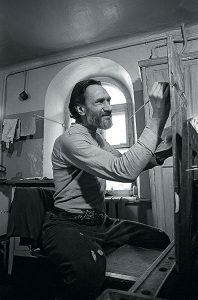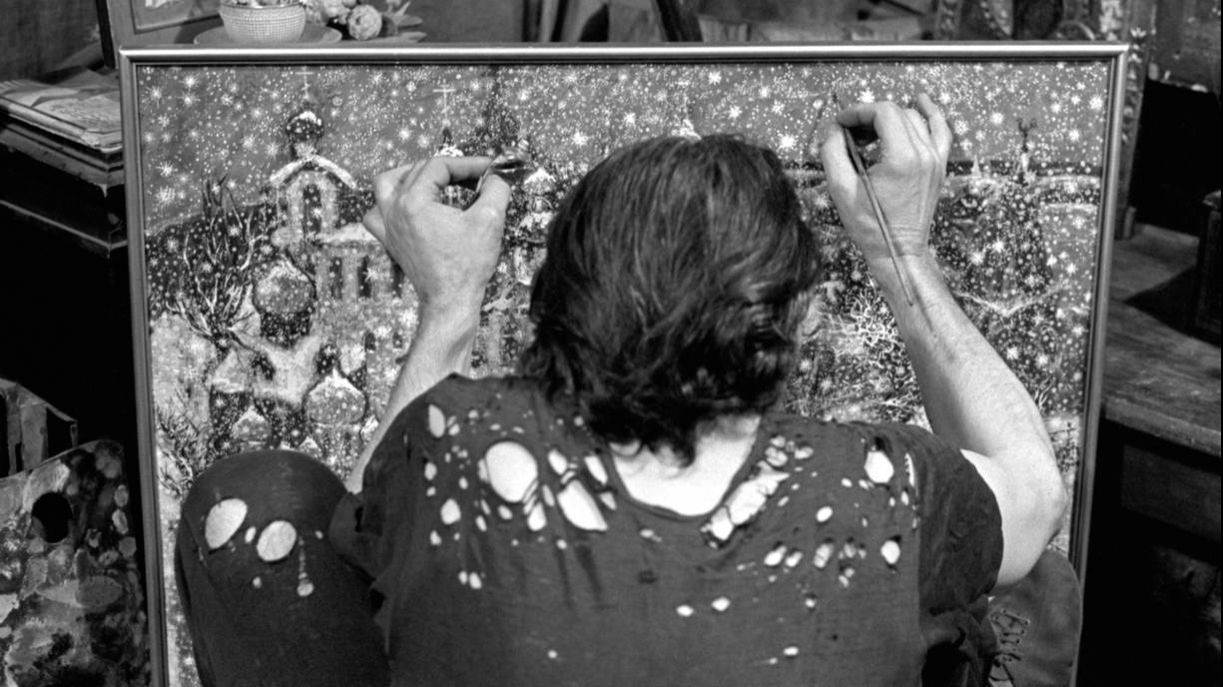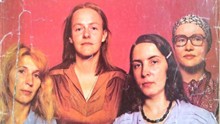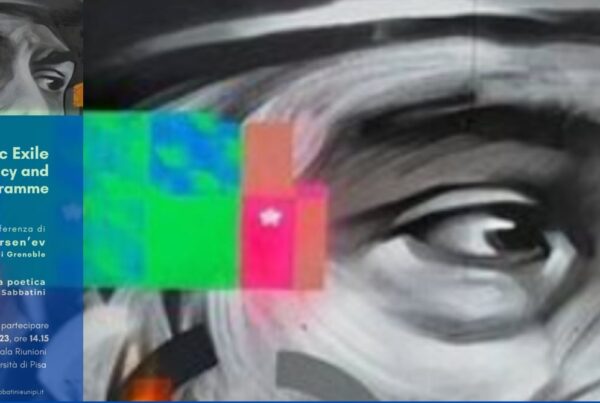Novo Rakitino, 1915 – New York, 1987

Vasilii Sitnikov in his apartment, Moscow, 1969. Photo by Igor’ Pal’min. Source: “Svoi krug“.
Vasilii Iakovlevich Sitnikov is considered an elder of the non-conformist artists (cf. Glezer 1986: 63). In the early 1950s, at the beginning of the Stalinist regime, long before the emergence of a true underground art scene, Sitnikov paved the way for free and independent art, in opposition to official visual culture. He was a pioneer not only in artistic production but also in training young artists and in opening new channels for disseminating art abroad.
Born during World War I into a peasant family from a village on the Don River, at the age of six Sitnikov moved to Moscow where he developed a passion for painting. He failed to gain admission to either the Academy of Fine Arts or the Moscow Art Institute in 1934 and 1935 and was largely self-taught. He earned a living through casual jobs and in 1938 found work as slide projectionist for classes in art history at the prestigious Surikov Art Institute (hence his nickname Vas’ka-Fonarshchik, Vas’ka the lamplighter). While working, he was able to attend drawing classes, where he made life drawings of models, still-lifes, plaster casts and copies of paintings. Inspired by this environment, he acquired the methods and techniques of the Academy, while rejecting its ideological approach and ended up “making beautiful dead portraits of living people” (cit. in Miele 1971: no page number).
In 1941, after Operation Barbarossa, Sitnikov began collecting Nazi propaganda leaflets, dropped by the Luftwaffe which were printed on coloured paper. Discovered by the military police, this unique drawing material led to Sitnikov’s arrest and detention in a psychiatric prison in Kazan’ throughout the years of WWII. Here, he sketched minute ink portraits of his fellow inmates, which testify his physical and mental sufferings.
In the early 1950s, Sitnikov began to give private painting lessons in his Moscow apartment, first in Rybnikov pereulok (1951-1964), then in Malaia Lubianka street (1964-1969), a stone’s throw from the KGB headquarters, and finally in Ibragimova street (1969-1975). His “domestic academy” represented one of the first training and meeting places for young artists outside the official milieu. Among his pupils were Aleksandr Kharitonov, Alëna Kirtsova, Vladimir Petrov-Gladkii, Vladimir Titov and Iurii Vedernikov. The Roman critic and painter Franco Miele, who frequently visited Sitnikov in his Moscow studio-apartment, wrote: “They contribute to the creation of several works by their master, like in an old art workshop, without any personal ambitions or cultural agenda. Meticulous craftsmanship is at the core of each work, in keeping with the subject which is dictated by Sitnikov himself, who then proceeds to finish the work” (Miele 1973: 460). The team working practices adopted during these lessons are evident in numerous four-handed drawings, mostly in pastel, pen and pencil on paper mounted on canvas which more often than not report the place and date of execution, the students’ names as well as comments in broken Russian about individual student’s progress. In such works, as well as in Sitnikov’s oeuvre at large, female figures are a recurrent subject, from life-drawings of models and portraits of acquaintances made during his self-taught years, to his later series on “bathers” or “gypsies”. Such works were generally inspired by a “mythical wife”, for whom he used a fetish-puppet as a model (cf. Sjeklocha, Mead 1967: 190). Such images of women, mostly devoid of any physiognomic traits and portrayed floating in amorphous spaces, are rendered through a sfumato technique and cool palettes of pastel colours tending towards monochrome.
A second recurring subject, which later became Sitnikov’s trademark, are his Kremlins, painted in bright colours covered in snow, lit by stars and sometimes with flocks of crows. These canvases have a fairy-tale atmosphere, with imagery alluding to folklore and ancient Rus’, and sometimes feature comical characters from Soviet daily life. They are executed in the format of the diptych and triptych, and often show Sitnikov himself painting the canvas, as a statement of his status as an artist. Other works feature self-portraits of Sitnikov’s in different guises, such as a cobbler, a shaman, or a drifter, which often emphasise the artist’s role as a craftsman or his nomadic status.
Sitnikov’s Kremlins were painted by request, at times on commission, for numerous foreign buyers residing or visiting Moscow. Indeed, from the 1950s, Sitnikov enjoyed the support of several diplomats, including the ambassadors of the United States, Spain and Tunisia, foreign collectors and journalists, such as Norton Dodge and Nina Stevens, the Russian wife of Edmund Stevens, the long-standing Moscow correspondent of several English newspapers.
Sitnikov’s canvases are both surreal and kitsch and met the tastes of Western collectors, also because they fed into common stereotypes about Russia to the extent that the artist earned the nickname “souvenir seller” (cf. Zagdansky 2002). A ubiquitous component is the falling snow that become a means for estimating the cost of a painting. As artist Vladimir Nemukhin recalls, Sitnikov established the following rule: “For every flake a ruble” (cit. in Ural’skii 1999: 9). Sitnikov’s art thus became part of the so-called dip-art phenomenon (from diplomatic art) which instead of referring to a specific style or genre came to define art disseminated and circulated abroad through diplomatic channels that protected it from investigation and seizure.
Between 1962 and 1963, Jimmy Ernst, son of surrealist painter Max Ernst, donated four of Sinitkov’s mixed media paintings to the Museum of Modern Art in New York, while in 1968, the Museum directly purchased a fifth work (Birch, 1961). Between 1963 and 1974, the MoMA regularly displayed the five paintings as “Recent acquisitions”. The Steppe (1960), the first work to enter the collection, was also included in the Contemporary Soviet Art exhibition which opened on September 26, 1974, as an act of solidarity towards Soviet artists after the famous Bulldozer Exhibition (in which Sitnikov did not actually participate, even though his name was printed among the exhibitors on the typewritten invitation). The MoMA acquisitions were a breakthrough for Sitnikov’s and for the entire first generation of non-conformist artists. Being known abroad, and recognised by the leading museum of modern art, considerably increased the artist’s prestige in the eyes of the collectors and art lovers travelling to Moscow with lists of artists worth a visit. From the 1960s, Sitnikov’s works were increasingly exhibited abroad in group shows of unofficial Soviet art. His first solo exhibition was held in 1971 in Italy, at the Centro di Iniziative Culturali in Avezzano, thanks to Franco Miele, who by then had already published an essay about the artist (cf. Miele 1970).
In October 1975, at the age of 60, Sitnikov was among the first Soviet nonconformist artists to leave the country. He spent five years in Austria, first in Vienna, then in Kitzbühel, where he worked for the “impresario”, gallery owner Ferdinand Maier. In 1977, he wrote to Carlo Ripa di Meana, then President of the Venice Biennale: “In Moscow I had a lot of money, but then I left Russia only with the clothes I had on. Here, I live like a wretch. I have no money, not even to send letters; I work very slowly” (La Biennale di Venezia, Archivio Storico delle Arti Contemporanee [ASAC], Fondo storico, Arti visive, b. 276). Sitnikov attended the Venice festival from mid-November of the same year, his art being presented in the group show New Soviet Art. An Unofficial Perspective, curated by Enrico Crispolti and Gabriella Moncada, which included ten of his works on loan from private Italian collections, for which Miele had acted as a mediator. Sitnikov’s exhibits were mainly mixed-media female nudes, presented in the catalogue as “idols” with “an accent of clear visionary vagueness” through “a plastic (vaguely neo-metaphysical) decantation” (Crispolti 1977: 53). Sitnikov’s works were displayed in the first section of the show, entitled Expressionist Figuration and Lyrical Figuration, along with well-known artists such as Ėrnst Neizvestnii and Oskar Rabin. Art critic Mario Perazzi from “Corriere della sera” disapproved of the Soviet art overall, but appreciated Sitnikov’s contributions such as Self-Portrait and Crows on the Kremlin (not printed in the catalogue, and hence probably added at the very last moment) as “one of the most authentically dissenting works in the show” (Perazzi 1977).
In 1980 Sitnikov left Europe to settle in New York, where he died seven years later. His last years were compromised by worsening health and economic conditions and a progressive isolation, due to nostalgia for Russia, poor market recognition and a shrinking number of pupils. One of his pupils, the poet Konstantin Kuz’minskii dedicated a festival to his teacher in 1985 in the Podval Gallery. Kuz’minskii is also credited with the publication of Zhitie Vasil’ Iaklicha Sitnikova, napisannoe i narisovannoe im samim (Life of Vasil’ Iaklich Sitnikov, written and painted by himself), a photostatic collection of autobiographical writings and reproductions of works, compiled between 1985 and 2009, which today is invaluable in providing information about Sitnikov’s life and oeuvre. Indeed, a substantial part of his works remain missing or in unknown locations, also because of his troubled biography and the poor, easily perishable media and materials used for many of his drawings and paintings.
In 2009, the art gallery Nashi khudozhniki (Our Artists) in Saint Petersburg held a retrospective show devoted to the artist. The exhibition, Vasilii Sitnikov i ego shkola (Vasilii Sitnikov and his school; cf. Vendel’shtein 2009), intended to shed light on Sitnikov’s dual role as an artist and a teacher, father and master of an artistic school. The exhibition brought together about a hundred works from public and private collections, including several four-handed works from lessons with his pupils (some of whom also contributed to the making of the exhibition). In such works, the master’s interventions and corrections are so frequent that the works must be at least in part attributed to him. Indeed, it is these works that are the best evidence of Sitnikov’s pedagogical mission, not only in training young artists, but in introducing them to a broad artistic network which has continued to flourish after the collapse of the Soviet Union.
Matteo Bertelé
[31st December 2022]
Bibliography
- Agostinelli A., Collezionisti italiani alla Biennale del dissenso: Franco Miele, Alberto Morgante e Alberto Sandretti, “eSamizdat”, 1, vol. VII (2009): 239-288, https://www.esamizdat.it/ojs/index.php/eS/issue/view/8, online (last accessed: 31/12/2022).
- Arkharova N., Tvorcheskii metod Vasiliia Sitnikova i ego shkola v 1960-70-kh godakh, “Vestnik GITIS”, 4 (2013): 161-168.
- Arkharova N., Tvorchestvo V.Ia. Sitnikova (1915-1987) i ego shkola v kontekste khudozhestvennoi zhizni Moskvy 1950-1980-kh gg., Avtoreferat, Moskovksaia Gosudarstvennaia Khudozhestvenno-promyshlennaia Akademiia imeni S. G. Stroganova, Moskva 2014.
- Argan G., Avanguardia, arte non conformista e guerra fredda. Franco Miele, un intellettuale italiano alla scoperta dell’arte sovietica, “eSamizdat”, vol. XIII (2020): 231-249, https://www.esamizdat.it/ojs/index.php/eS/article/view/89/79, online (last accessed: 31/12/2022).
- Bertelé M., Vasilij Sitnikov, Monastero, 1970, in G. Barbieri, S. Burini (eds.), Russie! Memoria mistificazione immaginario, exhibition catalogue (Ca’ Foscari Esposizioni, Venezia, 22 April-25 July 2010), Terra Ferma, Crocetta del Montello 2010: 129-130.
- Bertelé M., Sitnikov, Vasilij Jakovlevič, in Enciclopedia dell’arte contemporanea, vol. 4, Treccani, Roma 2021: 319.
- Burini S. (ed.), Da Avezzano con passione: un pezzo di Russia in Abruzzo. Alberto Morgante e la storia della sua collezione, “eSamizdat”, 1, a. VI (2008): 219-221, https://www.esamizdat.it/ojs/index.php/eS/issue/view/10, online (last accessed: 31/12/2022).
- Crispolti E., Moncada G. (eds.), La nuova arte sovietica. Una prospettiva non ufficiale, exhibition catalogue (Palazzetto dello Sport all’Arsenale, Venezia, 15 November-15 December 1977), Marsilio, Venezia 1977.
- Glezer A., Russkie khudozhniki na zapade, Tret’ia vol’na, Paris-New York 1986: 62-66, https://vtoraya-literatura.com/pdf/glezer_russkie_khudozhniki_na_zapade_1986__ocr.pdf, online (last accessed: 31/12/2022).
- Kuz’minskii K. (avt.-sost.), Zhitie Vasil’ Iaklicha Sitnikova, napisannoe i narisovannoe im samim, Lordville 2009.
- Miele F., Sogni e realtà di Wassilli [sic] Sitnikov, Prospettive, Roma [1970].
- Miele F. (ed.), Mostra antologica di Wassili Sitnikov. Opere dal 1931 al 1971, exhibition catalogue (Centro iniziative culturali, Avezzano, December 1971-January 1972), Avezzano 1971, in “eSamizdat”, 1, vol. VI (2008): 207-214, https://www.esamizdat.it/ojs/index.php/eS/issue/view/10, online (last accessed: 31/12/2022).
- Miele F., L’avanguardia tradita, Carte Segrete, Roma 1973.
- Perazzi M., Grandi artisti? Io dissento, “Corriere della sera”, 16 November 1977.
- Sieklocha P., Mead I., Unofficial Art in the Soviet Union, University of California Press, Berkeley-Los Angeles 1967: 185-196.
- Sitnikov Vasilii Iakovlevich, in Svoi krug. Khudozhniki-nonkoformisty v sobranii Aleksandra Kronika, http://www.svoykrug.com/Artists/sitnikov.html, online (last accessed: 31/12/2022).
- Ural’skii M., Nemukhinskie monologi, Bonfi, Moskva 1999.
- Vasya, directed by A. Zagdansky, USA, 2002.
- Vendel’shtein V. (ed.), Vasilii Sitnikov i ego shkola, exhibition catalogue (Galereia Nashi Khudozhniki, Sankt-Peterburg, 24 May-31 July 2009), Petronii, Sankt-Peterburg 2009.
To cite this article:
Matteo Bertelé, Vasilii Sitnikov. Between diplomacy and pedagogy, in Voci libere in URSS. Letteratura, pensiero, arti indipendenti in Unione Sovietica e gli echi in Occidente (1953-1991), a cura di C. Pieralli, M. Sabbatini, Firenze University Press, Firenze 2021-, <vocilibereurss.fupress.net>.
eISBN 978-88-5518-463-2
© 2021 Author(s)
Content license: CC BY 4.0





